
Thessaly is a traditional geographic and modern administrative region of Greece, comprising most of the ancient region of the same name. Before the Greek Dark Ages, Thessaly was known as Aeolia, and appears thus in Homer's Odyssey.
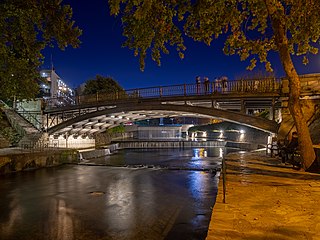
Trikala is a city in northwestern Thessaly, Greece, and the capital of the Trikala regional unit. The city straddles the Lithaios river, which is a tributary of Pineios. According to the Greek National Statistical Service, Trikala is populated by 81,355 inhabitants (2011), while in total the Trikala regional unit is populated by 131,085 inhabitants (2011).

Karditsa is a city in western Thessaly in mainland Greece. The city of Karditsa is the capital of Karditsa regional unit of region of Thessaly.

Great Vlachia or Great Wallachia, also simply known as Vlachia, was a province and region in southeastern Thessaly in the late 12th century, and was used to denote the entire region of Thessaly in the 13th and 14th centuries. The name derives from the Vlachs (Aromanians), who had lived across much of the area.

Markos Botsaris was a Souliot chieftain, general of the Greek revolutionary army and hero of the Greek War of Independence. He played a key role in relieving the First Siege of Missolonghi in 1822–1823 and was awarded the title of General of Western Greece by the revolutionary Greek government. He was killed during the Battle of Karpenisi and was buried in Missolonghi with full honors. Today Botsaris is among the most revered national heroes in Greece.
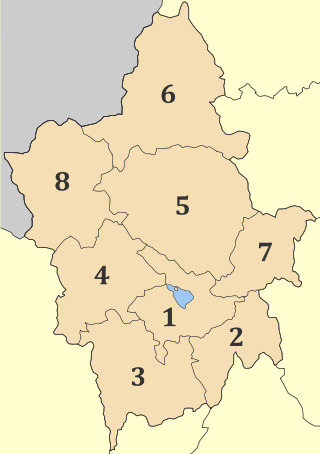
Ioannina is one of the regional units of Greece, located in the northwestern part of the country.
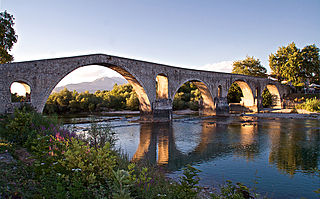
Arta is a city in northwestern Greece and capital of the regional unit of Arta, which is part of Epirus region. The city was known in ancient times as Ambracia. Arta is known for the medieval bridge over the Arachthos River, as well as for its ancient sites from the era of Pyrrhus of Epirus and its well-preserved 13th-century castle. Arta's Byzantine history is reflected in its many Byzantine churches; perhaps the best known is the Panagia Paregoretissa, built about 1290 by Despot Nikephoros I Komnenos Doukas.

Elassona is a town and a municipality in the Larissa regional unit in Greece. During antiquity Elassona was called Oloosson (Ὀλοοσσών) and was a town of the Perrhaebi tribe. It is situated at the foot of Mount Olympus. Elassona is bypassed by the GR-3.

Manuel Komnenos Doukas, Latinized as Ducas, commonly simply Manuel Doukas and rarely also called Manuel Angelos, was ruler of Thessalonica from 1230 to 1237 and, after his expulsion from Thessalonica, of Thessaly from 1239 until his death in c. 1241.
The history of Thessaly covers the history of the region of Thessaly in north-central Greece from antiquity to the present day.

John I Doukas, Latinized as Ducas, was an illegitimate son of Michael II Komnenos Doukas, Despot of Epirus in c. 1230–1268. After his father's death, he became ruler of Thessaly from c. 1268 to his own death in 1289. From his father's family he is also inaccurately known as John Angelos.

Tyrnavos is a municipality in the Larissa regional unit, of the Thessaly region of Greece. It is the second-largest town of the Larissa regional unit, after Larissa. The town is near the mountains and the Thessalian Plain. The river Titarisios, a tributary of the Pineios, flows through the town. Tyrnavos is bypassed by the Greek National Road 3. Tyrnavos is located south-southwest of Thessaloniki and Katerini, northwest of Larissa, east-northeast of Trikala and south-southeast of Elassona and Kozani. Here live an important community of Aromanians (Vlachs).

Pyli is a municipality in the Trikala regional unit, Greece. Situated 18 km west of Trikala, right at the bottom of two mountains Itamos, and Koziakas, which mark the beginning of the Pindos mountainline, Pyli marks the entrance to a great gorge and the natural path that leads to the city of Arta. The river Portaikos, a tributary of the river Pineios, runs through this location. The municipality of Pyli contains 7 municipal units, but the town itself has a population of about 4,000. Most inhabitants are either self-employed in business establishments. Agriculture and animal herding as an occupation has been largely abandoned, though the surrounding area is ideal for both. Pyli had always been the major trade center for the surrounding settlements.

Aspropotamos is a former community in the Trikala regional unit, Thessaly, Greece. Since the 2011 local government reform it is part of the municipality Meteora, of which it is a municipal unit. The 2021 census recorded 218 residents in the municipal unit. The seat of the community was in Kallirroi.
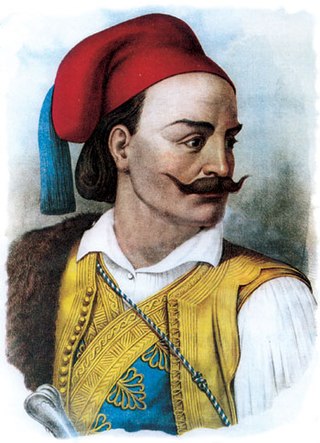
Kitsos Tzavelas was a Souliot fighter and general of the Greek rebels in the Greek War of Independence. After the establishment of the Kingdom of Greece he entered Greek politics and served as Minister of Military Affairs (1847-1848) and as Prime Minister (1847).
Sebastokrator, was a senior court title in the late Byzantine Empire. It was also used by other rulers whose states bordered the Empire or were within its sphere of influence. The word is a compound of sebastós and krátōr. The wife of a Sebastokrator was named sebastokratorissa in Greek, sevastokratitsa (севастократица) in Bulgarian and sevastokratorica in Serbian.
The Battle of Mouzaki occurred on 4 May 1878 between Greek irregulars with the cover support of the Greek Army against the Ottoman Army.
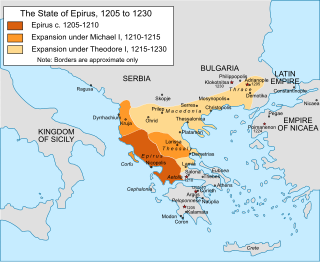
The Empire of Thessalonica is a historiographic term used by some modern scholars to refer to the short-lived Byzantine Greek state centred on the city of Thessalonica between 1224 and 1246 and ruled by the Komnenodoukas dynasty of Epirus. At the time of its establishment during the struggle for Constantinople, the Empire of Thessalonica, under the capable Theodore Komnenos Doukas, rivaled the Empire of Nicaea and the Second Bulgarian Empire as the strongest state in the region, and aspired to capturing Constantinople, putting an end to the Latin Empire, and restoring the Byzantine Empire that had been extinguished in 1204.
Constantine Komnenos Maliasenos Doukas Bryennios was a Byzantine Greek nobleman and magnate active in Thessaly in the first half of the 13th century.
Nicholas Komnenos Angelos Doukas Bryennios Maliasenos was a Byzantine Greek nobleman and magnate active in the region of Volos in Thessaly the second half of the 13th century.
















